

Israeli Prime Minister Benjamin Netanyahu has flatly rejected Hamas’s proposed terms for a temporary ceasefire, instead issuing orders to prepare for an offensive in the southern Gaza Strip. The plan would specifically target the Rafah area, which has become a haven for many Palestinians fleeing the conflict. Across the United States, Europe, and the Arab world, there are grave concerns that such a military operation will trigger a humanitarian crisis worse than any of the past several months. However, it is clear that without pushing forward, Israel’s chances of dismantling Palestinian militant groups, securing the release of hostages, and establishing lasting security in the region, are slim. The Insider has examined the past three decades of urban warfare in order to assess what recent conflicts might foreshadow for the future of Rafah.
Content
Sarajevo (1992–1996)
Grozny (1999–2000)
Fallujah (2004)
Aleppo (2012–2016)
Mosul (2016–2017)
Mariupol (2022)
Gaza (2023–2024)
What lies ahead for civilians in Rafah?
After Israeli forces secured control over the northern and central regions of the Gaza Strip, including Gaza City itself, clashes with Hamas militants shifted southward to Khan Yunis. Casualties have risen among both the IDF, with 24 soldiers killed in a single day on January 23, and among local residents, surpassing 28,000 according to reports from the Hamas government's Ministry of Health in Gaza (which Israeli intelligence relies upon as a source for better understanding the cost of the conflict).
Now Israeli troops will face an even greater challenge — the assault on Rafah in the southern sector, near the Egyptian border. Since the onset of this iteration of the conflict on October 7 of last year, Rafah has become a refuge for displaced civilians seeking relative safety. If the Israeli leadership persists in fully occupying Gaza and dismantling Palestinian factions, the IDF will find itself fighting in unprecedented proximity to densely populated civilian areas.
Russian Internal Troops
Transformed into the National Guard troops in 2016.
Barrel bombs
Barrel bombs are improvised aerial munitions used by government forces during the Syrian Civil War. They typically consist of a metal cylinder filled with explosives and equipped with rudimentary stabilizers. Barrel bombs are dropped from transport helicopters over residential neighborhoods and, due to their extreme imprecision, often result in significant civilian casualties.
MLRS
MLRS stands for Multiple Launch Rocket System. It is a system that launches rockets one after another, increasing the firepower of the salvo.
The IDF will find itself fighting in unprecedented proximity to densely populated civilian areas
Having studied several examples of sieges and assaults on major cities in recent history, The Insider can lay out the range of possibilities for the future of Rafah — and for its civilian population.
Sarajevo (1992–1996)
Population: 527,000 (as of 1991)
Defending force: 25,000–70,000
Defenders' losses: over 6,000
Civilian casualties: 5,434–11,541
The siege of Sarajevo, Bosnia and Herzegovina's capital, endured for 1,425 days, beginning almost immediately after the country declared independence in 1992. The city found itself encircled by forces from the Yugoslav People's Army, aided by Yugoslav-backed factions of the Republic of Serbia commanded by Ratko Mladić, who was later convicted in The Hague for war crimes. Possessing superior artillery, the besiegers subjected the city to relentless shelling, averaging 329 strikes per day. Among the most notorious attacks was the mortar attack on the bustling Markale market on February 5, 1994, which took 68 lives and injured 200.
Russian Internal Troops
Transformed into the National Guard troops in 2016.
Barrel bombs
Barrel bombs are improvised aerial munitions used by government forces during the Syrian Civil War. They typically consist of a metal cylinder filled with explosives and equipped with rudimentary stabilizers. Barrel bombs are dropped from transport helicopters over residential neighborhoods and, due to their extreme imprecision, often result in significant civilian casualties.
MLRS
MLRS stands for Multiple Launch Rocket System. It is a system that launches rockets one after another, increasing the firepower of the salvo.
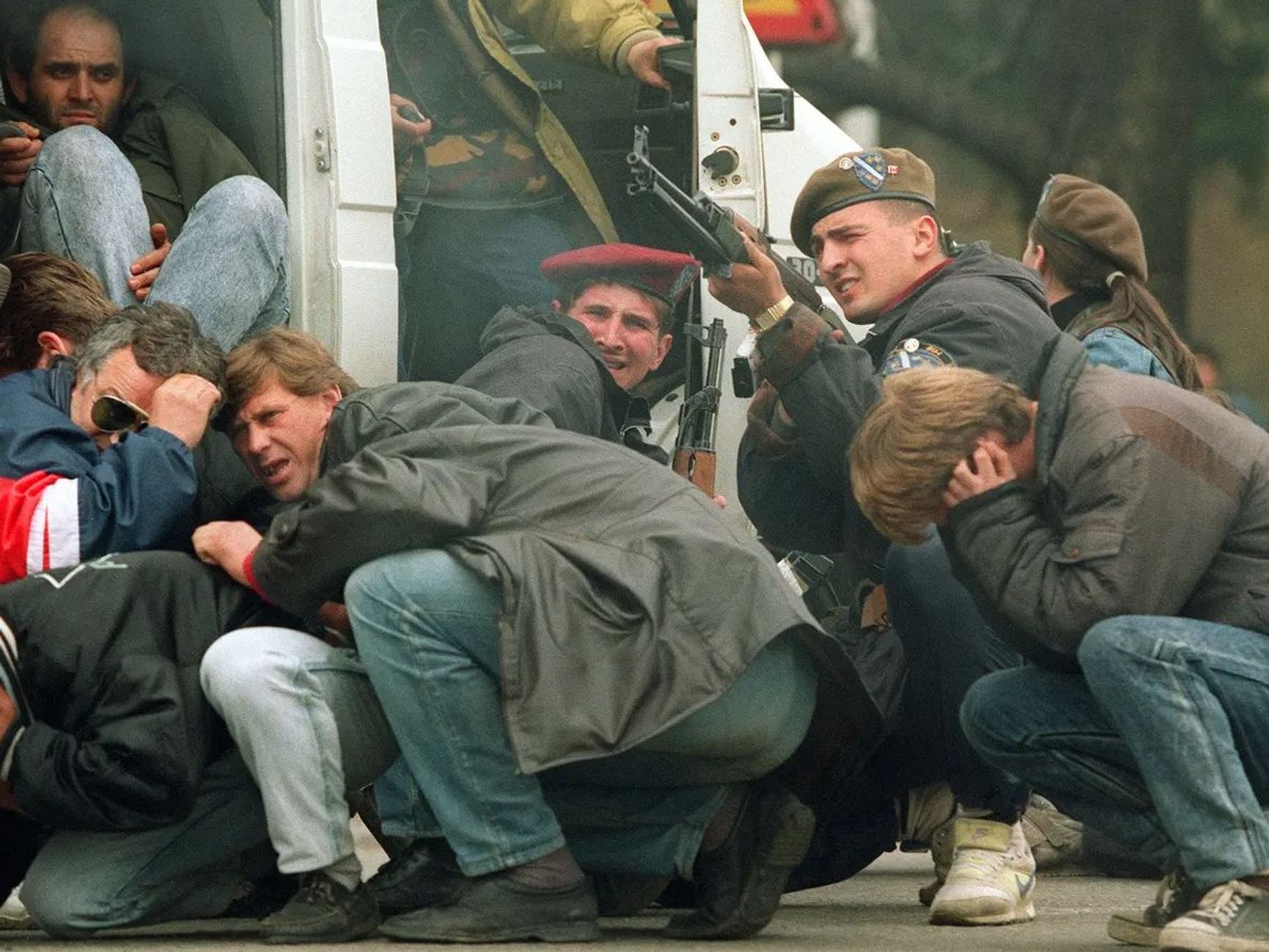
Sarajevo, April 1992
Mike Persson / AFP / Getty Images
Despite making gains in certain sectors, notably Novo Sarajevo, the attackers could not overcome the resilience of the defenders. Their efforts were thwarted for good in 1995 when NATO airstrikes targeted positions around the city, compelling the attackers to lift the siege.
Grozny (1999–2000)
Defending force: 3,000–5,000
Population: 15,000–50,000 (the majority fled the city before the siege began)
Defenders' losses: 1,500–2,000
Civilian casualties: 5,000–8,000
The Chechen forces fighting against the Russian assault in September 1999 were largely from the Chechen Republic of Ichkeria movement, which ultimately lost control of the region to the Kadyrov clan. After raids by Ichkerian guerrilla leader Shamil Basayev in Dagestan, Russian forces entered Chechnya and commenced airstrikes on Grozny. By early November, Russian forces had effectively besieged the city and began advancing toward its center from various directions. Specially formed assault units from the Russian Armed Forces and Interior Troops were involved in the offensive.
Russian Internal Troops
Transformed into the National Guard troops in 2016.
Barrel bombs
Barrel bombs are improvised aerial munitions used by government forces during the Syrian Civil War. They typically consist of a metal cylinder filled with explosives and equipped with rudimentary stabilizers. Barrel bombs are dropped from transport helicopters over residential neighborhoods and, due to their extreme imprecision, often result in significant civilian casualties.
MLRS
MLRS stands for Multiple Launch Rocket System. It is a system that launches rockets one after another, increasing the firepower of the salvo.

Grozny, February 2000
EPA
The conflict in Grozny saw relentless airstrikes and artillery bombardments, including the use of 240-millimeter self-propelled mortars known as “Tulips.” Additionally, ballistic missiles including the “Elbrus” and “Tochka-U” were deployed. Allegedly, it was the latter, possibly in cluster form, that struck a maternity hospital, mosque, and market on October 21, 1999, resulting in the deaths of over 100 civilians. The city's infrastructure sustained such severe damage that in 2003, the UN declared Grozny the most devastated city on Earth.
Russian Internal Troops
Transformed into the National Guard troops in 2016.
Barrel bombs
Barrel bombs are improvised aerial munitions used by government forces during the Syrian Civil War. They typically consist of a metal cylinder filled with explosives and equipped with rudimentary stabilizers. Barrel bombs are dropped from transport helicopters over residential neighborhoods and, due to their extreme imprecision, often result in significant civilian casualties.
MLRS
MLRS stands for Multiple Launch Rocket System. It is a system that launches rockets one after another, increasing the firepower of the salvo.
In 2003, the UN declared Grozny the most devastated city on Earth
The fighting was extremely intense. Chechen forces occasionally managed to infiltrate Russian lines by passing through sewage tunnels, cutting off isolated groups of soldiers. However, by the beginning of February, the defenders’ situation became desperate, and they attempted to break out of the city. During this breakout, numerous Ichkerian fighters and civilians were killed under Russian bombardment. Afterward, the Russians cleared the city, and by February 6, they raised the Russian flag over one of its administrative buildings. Despite this Russian “victory,” partisan activities continued afterward.
Fallujah (2004)
Defending force: 3,700–4,000
Population: 30,000–90,000
Defenders' losses: 1,200–2,000
Civilian casualties: 581–800
(the above figures relate to the second battle of Fallujah)
While the invasion of Iraq in 2003 saw swift success for the American-British coalition forces, with Baghdad falling just days after the U.S. advance, the situation dramatically worsened by 2004. A variety of insurgent groups, ranging from radical Islamists to loyalists of Saddam Hussein, rebelled against coalition forces and against the Iraqi transitional government the Western contingent supported. Fallujah emerged as a key battleground after Abu Musab al-Zarqawi rose to prominence. He soon became the leader of al-Qaeda in Iraq.
Following the killing of Blackwater contractors in the city on March 31, 2004, the initial American attempt to take control of Fallujah ended in failure. By November, despite an agreement to transfer control of the city to Iraqi transitional authorities, the number of insurgents there had swelled. Coalition forces made up of Americans and Iraqi government special forces, began preparing for a decisive operation.
As the U.S. established checkpoints and conducted extensive reconnaissance. The insurgents fortified their positions, setting traps and deploying homemade explosive devices throughout the city. Despite these preparations, the majority of the population managed to evacuate before the start of the battle.
Russian Internal Troops
Transformed into the National Guard troops in 2016.
Barrel bombs
Barrel bombs are improvised aerial munitions used by government forces during the Syrian Civil War. They typically consist of a metal cylinder filled with explosives and equipped with rudimentary stabilizers. Barrel bombs are dropped from transport helicopters over residential neighborhoods and, due to their extreme imprecision, often result in significant civilian casualties.
MLRS
MLRS stands for Multiple Launch Rocket System. It is a system that launches rockets one after another, increasing the firepower of the salvo.
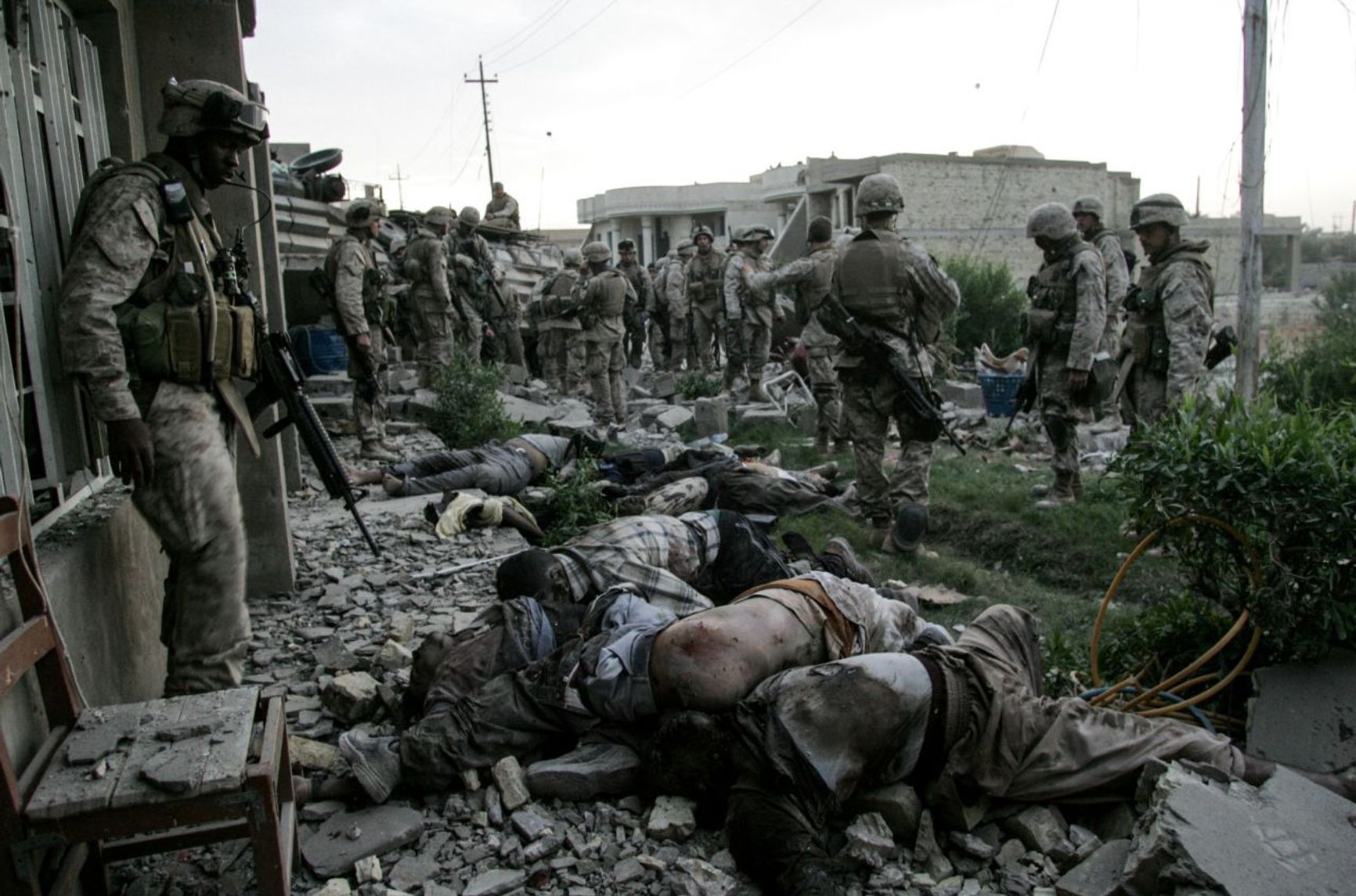
Fallujah, November 2004
Jérôme Sessini / Magnum Photos
The assault began on November 7-8 with support from artillery, aviation, and drones. These assets, coupled with the swift clearing of streets by armored bulldozers, allowed combat operations to conclude by November 16, although clearing operations in the city continued until December 23. Despite its brevity, the operation was remembered as the most intense urban combat involving the U.S. since the Vietnam War.
Russian Internal Troops
Transformed into the National Guard troops in 2016.
Barrel bombs
Barrel bombs are improvised aerial munitions used by government forces during the Syrian Civil War. They typically consist of a metal cylinder filled with explosives and equipped with rudimentary stabilizers. Barrel bombs are dropped from transport helicopters over residential neighborhoods and, due to their extreme imprecision, often result in significant civilian casualties.
MLRS
MLRS stands for Multiple Launch Rocket System. It is a system that launches rockets one after another, increasing the firepower of the salvo.
The operation was the most intense urban combat involving the US since the Vietnam War
Precision munitions were used during the bombings, but Fallujah’s infrastructure still suffered greatly — between 7,000 and 10,000 buildings out of the city’s total of 50,000 were destroyed. Subsequently, U.S. forces were accused of using incendiary white phosphorus munitions, which the Pentagon eventually admitted to. The deaths of hundreds of civilians were attributed to the Americans' use of significant firepower to suppress individual insurgent positions, as well as to the lack of medical supplies in city hospitals.
Aleppo (2012–2016)
Defending force: 7,000–15,000
Population: 300,000 (by the end of the siege)
Losses on both sides: 7,500
Civilian casualties: 23,500
The siege of Aleppo, carried out by forces loyal to Bashar al-Assad's regime and backed by pro-Iranian militias and Russian airstrikes, stands as one of the defining chapters of the Syrian civil war. Before the battle itself, the city endured years of relentless artillery shelling, indiscriminate bombings with improvised “barrel bombs,” and chemical attacks.
In 2016, bolstered by support from the Russian Air Force, Syrian government troops successfully severed eastern Aleppo from the Turkish border, thus cutting off a crucial supply route for the anti-Assad rebel groups still holding positions in the city. Subsequently, the besieging forces managed to encircle the rebel-controlled area and secure access routes to the government-held portion of the city, which itself was in a semi-besieged state.
Russian Internal Troops
Transformed into the National Guard troops in 2016.
Barrel bombs
Barrel bombs are improvised aerial munitions used by government forces during the Syrian Civil War. They typically consist of a metal cylinder filled with explosives and equipped with rudimentary stabilizers. Barrel bombs are dropped from transport helicopters over residential neighborhoods and, due to their extreme imprecision, often result in significant civilian casualties.
MLRS
MLRS stands for Multiple Launch Rocket System. It is a system that launches rockets one after another, increasing the firepower of the salvo.

Aleppo, September 2016
Source: Reuters Photo
Following the encirclement, the city endured intense bombardment, which included the use of concrete-piercing aerial bombs. According to an estimate, civilian casualties from Russian airstrikes alone amounted to no fewer than 1,640 people. Assad's opponents surrendered district by district until finally, on December 13, only 5% of the city's territory remained under their control.
Subsequently, the parties reached an agreement for the evacuation of remaining fighters, their families, and activists (including journalists and bloggers covering the siege in the media) to other areas of Syria not under government control. After this, pro-Assad forces declared full control over Aleppo. However, the war-torn country had no money available for the city's reconstruction, and a significant portion of it still lies in ruins.
Mosul (2016–2017)
Population: Up to 1.5 million
Defending force: 6,000–12,000
Defenders' losses: 8,000–11,000
Civilian casualties: 9,500–11,000
The capture of Iraqi Mosul in 2014 and the subsequent triumphant speech by Abu Bakr al-Baghdadi, the leader of the “Islamic State,” at the Great Mosque of al-Nuri, marked a significant triumph for the group during its rapid military expansion. These events prompted the U.S. to redeploy troops to Iraq after having completed its initial withdrawal from the country in 2011. American soldiers back on the ground commenced the fight against Islamist forces, collaborating with other Western nations and local militias. By October 2016, Iraqi government forces and Kurdish Peshmerga fighters had encircled Mosul and were preparing for a major offensive.
The battle for Mosul was characterized by intense artillery bombardments and airstrikes. Western forces used HIMARS MLRS, CAESAR self-propelled howitzers, and M777 howitzers — all three of which later played key roles on the Ukrainian side in its fight to push back Russian territorial gains following its full-scale invasion of February 24, 2022. In Iraq, the militants responded with mortar fire, often indiscriminate, and the burning of tires to obscure visibility and hinder airstrikes. Additionally, both sides relied on the extensive utilization of drones for dropping munitions on enemy forces.
Russian Internal Troops
Transformed into the National Guard troops in 2016.
Barrel bombs
Barrel bombs are improvised aerial munitions used by government forces during the Syrian Civil War. They typically consist of a metal cylinder filled with explosives and equipped with rudimentary stabilizers. Barrel bombs are dropped from transport helicopters over residential neighborhoods and, due to their extreme imprecision, often result in significant civilian casualties.
MLRS
MLRS stands for Multiple Launch Rocket System. It is a system that launches rockets one after another, increasing the firepower of the salvo.
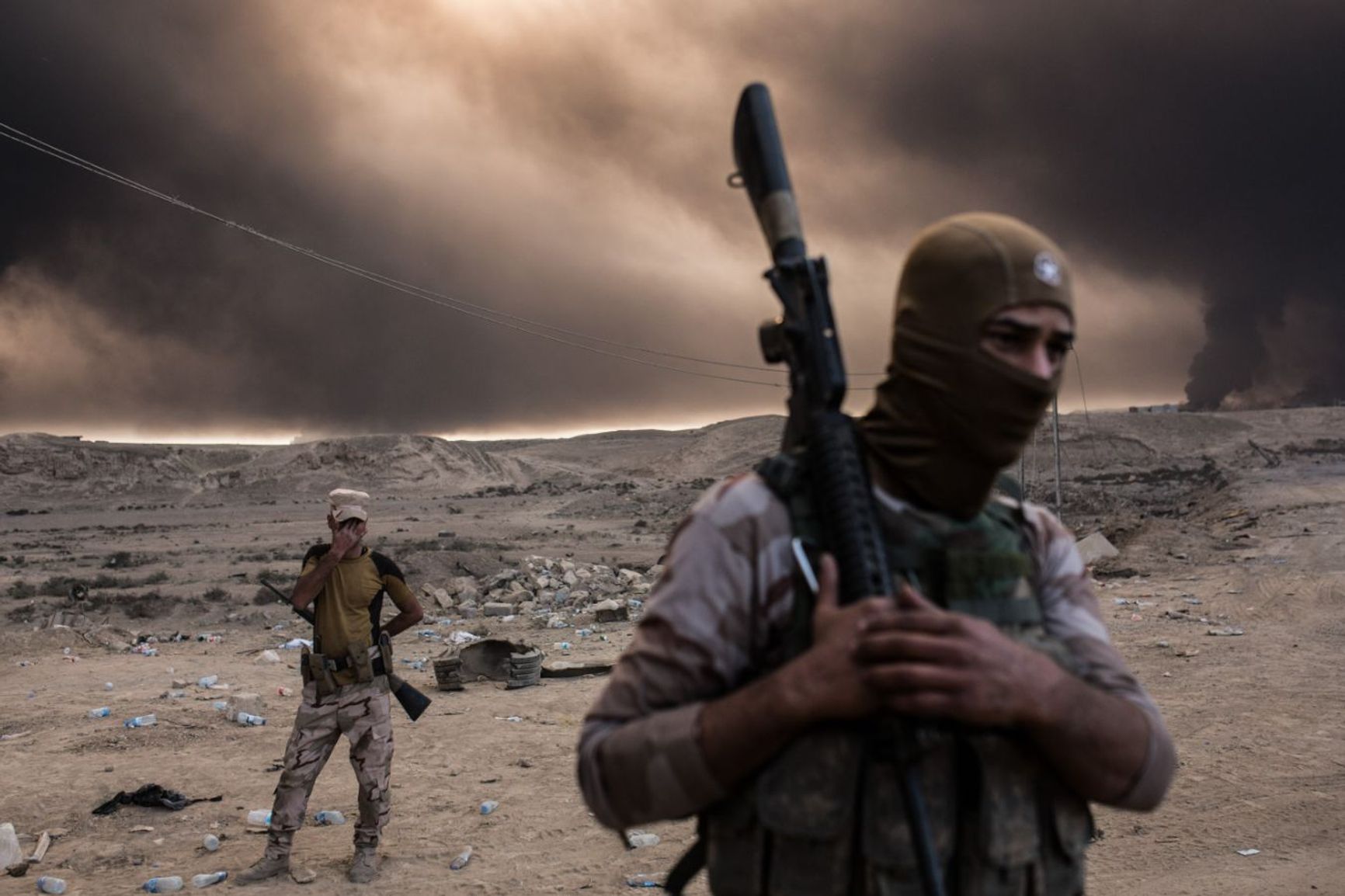
Mosul, October 2016
AFP
The fighting in Mosul unfolded with intense combat occurring literally block by block. Adding to the complexity was the significant presence of civilians, as militants prevented their escape from the city (while also carrying out mass executions, often on charges of espionage). In response, Iraqi government forces and Shiite militias resorted to the torture and execution of captured fighters. Coalition airstrikes further exacerbated the situation, resulting in significant civilian casualties. For instance, in March 2017, the U.S. acknowledged its responsibility for an airstrike that claimed the lives of 200 people. American officials accused the militants of using civilians as human shields.
Russian Internal Troops
Transformed into the National Guard troops in 2016.
Barrel bombs
Barrel bombs are improvised aerial munitions used by government forces during the Syrian Civil War. They typically consist of a metal cylinder filled with explosives and equipped with rudimentary stabilizers. Barrel bombs are dropped from transport helicopters over residential neighborhoods and, due to their extreme imprecision, often result in significant civilian casualties.
MLRS
MLRS stands for Multiple Launch Rocket System. It is a system that launches rockets one after another, increasing the firepower of the salvo.
Militants prevented civilians from leaving the city and carried out mass executions, often on charges of espionage
The battles for Mosul led to a humanitarian crisis of unprecedented scale. By March 2017, as the fighting drew to a close, an estimated 750,000 people still lacked access to vital humanitarian aid. Even two years after the “Islamic State” was finally defeated, 300,000 residents of Mosul were still unable to return to their homes due to the extensive destruction inflicted during the conflict.
Mariupol (2022)
Population: 425,000
Defending force: 3,500–8,000
Defenders' losses: 906–4,200
Civilian casualties: 3,000–25,000
Mariupol stands out as the largest city captured by the Russian Armed Forces during the Russo-Ukrainian War. The swift advance from Crimea enabled Russian troops to breach Ukrainian defenses in the southern Donetsk Oblast and to encircle Mariupol by early March 2022. The city faced indiscriminate bombardments and shelling from various artillery pieces and missile systems, including ballistic missiles like the aforementioned “Tochka-U,” along with thermobaric munitions from the heavy flamethrower system TOS-1A.
Accusations from Ukrainian authorities, journalists, and human rights organizations pointed to Russia's targeting of civilian infrastructure. Particularly egregious incidents include the bombing of a maternity hospital and a children's clinic on March 9, as well as an attack on the Mariupol Drama Theater on March 16. The precise death toll of civilians who sought refuge in the basement of the building remains unknown. While Russian military officials and propagandists alleged that it was “Ukrainian neo-Nazis” who were responsible for blowing up residential areas in Mariupol, claiming that the Russian Armed Forces only targeted military objectives, the Russian military’s use of unguided aerial bombs in urban settings during the battle renders those excuses dubious at best.
Russian Internal Troops
Transformed into the National Guard troops in 2016.
Barrel bombs
Barrel bombs are improvised aerial munitions used by government forces during the Syrian Civil War. They typically consist of a metal cylinder filled with explosives and equipped with rudimentary stabilizers. Barrel bombs are dropped from transport helicopters over residential neighborhoods and, due to their extreme imprecision, often result in significant civilian casualties.
MLRS
MLRS stands for Multiple Launch Rocket System. It is a system that launches rockets one after another, increasing the firepower of the salvo.
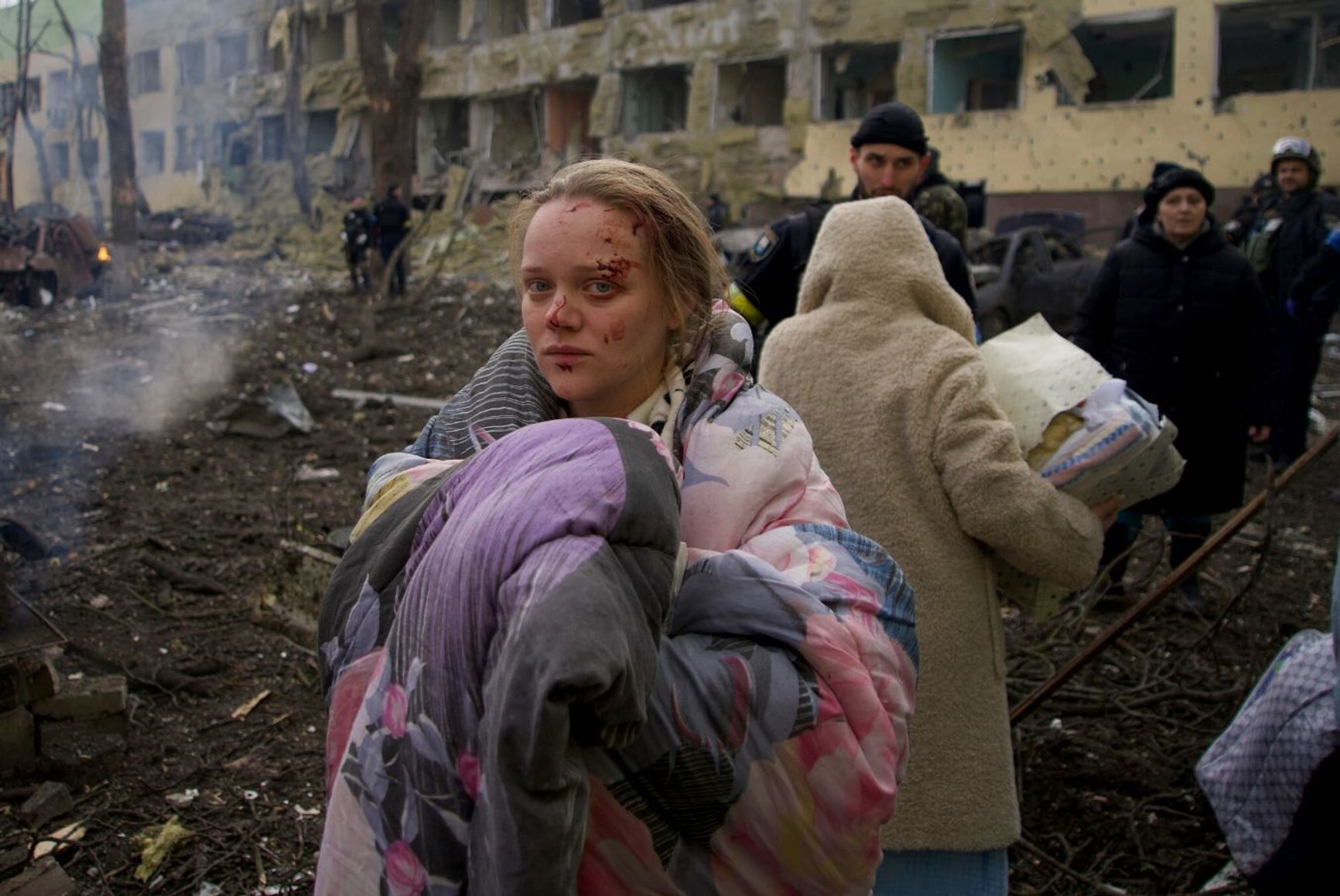
Mariupol, March 2022
Mstyslav Chernov / AP Photo
The overwhelming firepower superiority of Russian forces compelled Mariupol's defenders to retreat until they were pushed onto the territory of the Azovstal plant complex, which was all but completely destroyed during the siege. In May 2022, the majority of the city's defenders surrendered, with many remaining in captivity to this day. The accurate determination of civilian casualties remains challenging, as acknowledged by the United Nations; at the time of publication, there are over 1,000 confirmed deaths, while satellite imagery shows mass graves large enough to hold tens of thousands of corpses.
Gaza (2023–2024)
Population: 2.4 million
Defending force: 25,000–40,000
Defenders' losses: 5,000–9,000
Civilian casualties: up to 20,000
Israeli air and ground operations in Gaza commenced shortly after the October 7, 2023 attack by Hamas militants, which claimed the lives of over 1,000 Israelis (mostly civilians). Despite ongoing attacks by Palestinian factions, the IDF managed to advance with relatively minor losses — attributable at least in part to the high intensity of Israeli airstrikes, which, according to various reports, have destroyed or damaged between 30-50% of all buildings in the Gaza Strip.
Russian Internal Troops
Transformed into the National Guard troops in 2016.
Barrel bombs
Barrel bombs are improvised aerial munitions used by government forces during the Syrian Civil War. They typically consist of a metal cylinder filled with explosives and equipped with rudimentary stabilizers. Barrel bombs are dropped from transport helicopters over residential neighborhoods and, due to their extreme imprecision, often result in significant civilian casualties.
MLRS
MLRS stands for Multiple Launch Rocket System. It is a system that launches rockets one after another, increasing the firepower of the salvo.
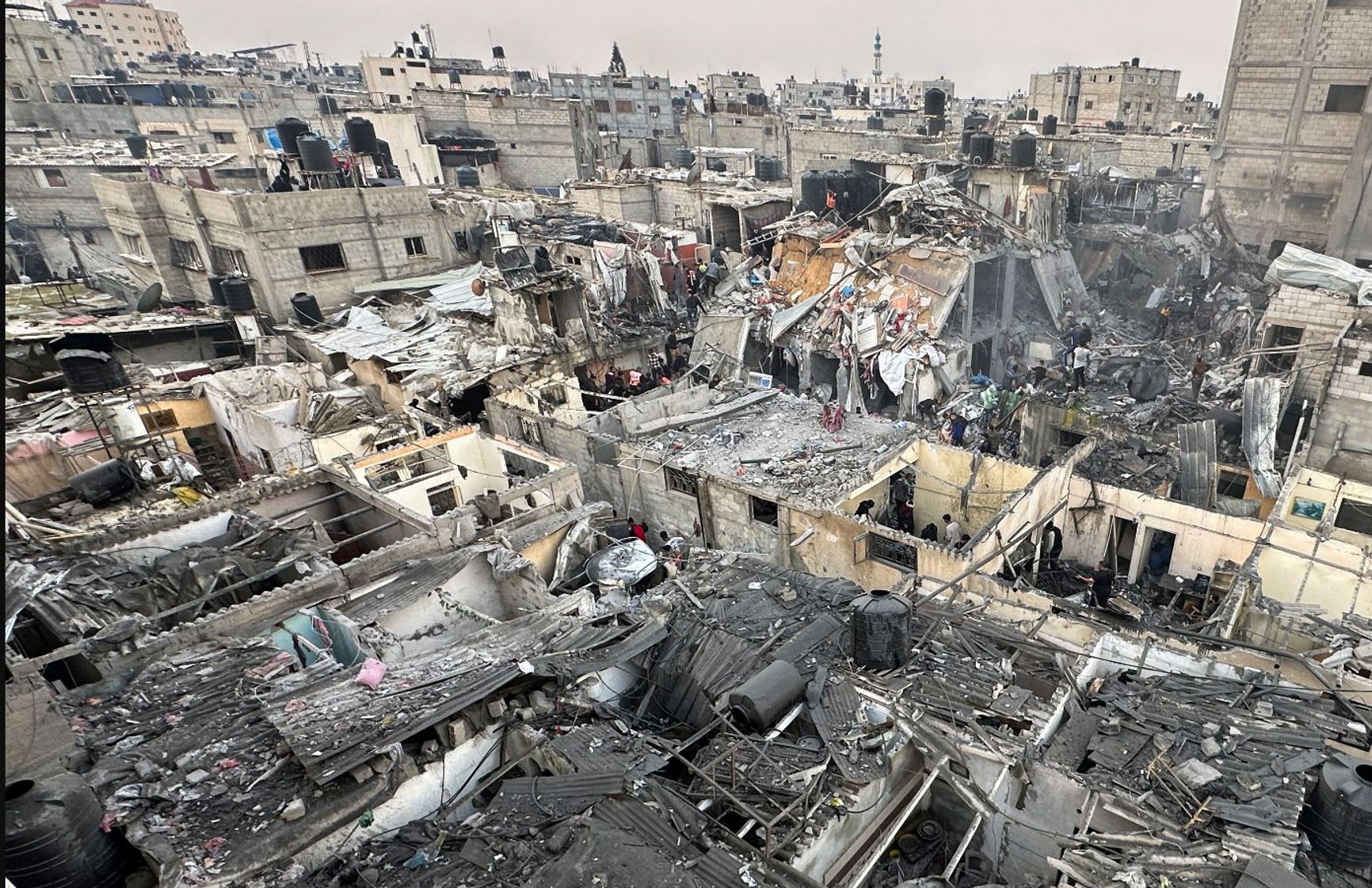
Rafah, December 2023
Fadi Shana / Reuters
According to Gaza's Hamas-controlled Ministry of Health, by early February, the death toll had surpassed 28,000 people (a total consisting of both civilians and members of Hamas and other militant groups). While the IDF does not officially acknowledge these figures, it is likely not far off from the actual count. In December, it was estimated that, for every terrorist killed, two Palestinian civilians also die, and assessments from Israeli and American intelligence suggest that anywhere from 5,000-9,000 militants have been killed. Four months into the operation, the number of civilian casualties may well be just under 20,000.
Israeli military expert David Gendelman, in conversation with The Insider, claimed that the civilian death toll was “quite small for a war of such scale and intensity” and that without the precautionary measures taken by the IDF, it would have been much higher:
“In a combat zone, it's inherently impossible to provide absolute safety guarantees for civilians. However, efforts can be undertaken to minimize casualties, such as those employed by the Israel Defense Forces: issuing advance warnings for residents to evacuate specific areas, setting up humanitarian zones, corridors, and ceasefires, and utilizing precision weaponry whenever feasible. While it's impractical to rely solely on precision weapons in a major conflict, every effort is made to employ them when possible. Additionally, strikes are halted during targeted killings if civilians are in proximity, among other measures.”
Russian Internal Troops
Transformed into the National Guard troops in 2016.
Barrel bombs
Barrel bombs are improvised aerial munitions used by government forces during the Syrian Civil War. They typically consist of a metal cylinder filled with explosives and equipped with rudimentary stabilizers. Barrel bombs are dropped from transport helicopters over residential neighborhoods and, due to their extreme imprecision, often result in significant civilian casualties.
MLRS
MLRS stands for Multiple Launch Rocket System. It is a system that launches rockets one after another, increasing the firepower of the salvo.
In a combat zone, it's inherently impossible to provide absolute safety guarantees for civilians
Another Israeli military expert, David Sharp, highlighted to The Insider that, given the technological capabilities of the Israeli army, no guarantees can be offered to the civilian population. Still, unjustified losses can be minimized:
“Undoubtedly, technology, especially in terms of reconnaissance, situational awareness, and precision munitions, significantly reduces the number of casualties compared to what could have been seen, say, using weapons from the time of the Second World War — or even later.
Many Hamas targets are located directly under, if not alongside, residential buildings. If, instead of the Israeli army, any Western army were involved in such combat actions, I have no doubt there would be more casualties — possibly significantly more.”
Sharp lauded the measures the IDF has taken to alert Gaza residents about the army's impending actions in a timely manner. This has included distributing leaflets with detailed instructions and maps, mass messaging via mobile communication, and even loudspeakers installed on drones.
Israeli military observer Sergey Auslander believes that the overall approach of the IDF plays an important role:
“We have complex weapon use protocols. We have a list of targets, for example, vetted by army lawyers who verify whether it will lead to consequences.”
What lies ahead for civilians in Rafah?
Despite all the precautions taken by the IDF, significant civilian casualties among Palestinians are inevitable. Here's why.
Firstly, refugees have no access to Israel or neighboring Egyptian territories, which compels them to move to the less affected southern part of the enclave, which is still subject to airstrikes.
Secondly, over 40% of the aerial munitions used by the Israeli Air Force are unguided, according to US intelligence.
Thirdly, questions arise about the IDF's target selection. For instance, the strike on the Jabalia refugee camp on October 31 resulted in the death of not only a Hamas battalion commander, but also dozens of civilians.
These incidents, extensively covered by international media, consistently prompt Israel's American allies to call for a reduction in the scale of operations and to transition to more “targeted” strikes. Some Israeli officials, including Defense Minister Yoav Galant, have expressed Israel's intention to do so. However, this might leave the objective of eliminating Hamas unfulfilled, while the continuation of the “intensive phase” in southern Gaza could lead to even more civilian deaths.
In summary, a high level civilian casualties may stem from indiscriminate attacks (as seen in Sarajevo, Grozny, Aleppo, Mariupol, and Mosul), the population's inability to leave the city (Sarajevo, Mariupol, Mosul), and the fierce resistance by defenders, met with excessive force in response (Grozny, Fallujah, Mariupol, Mosul).
To some extent, all these factors are applicable to Gaza, particularly its southern region, where a substantial portion of the population resides alongside the last remaining battalions of Hamas. For both civilians and militants, there are limited options for escape, and any unintended errors in the attackers' use of weaponry could lead to widespread civilian casualties.
Difficulty also lies in the fact that, even if the attacking side intends to minimize civilian casualties, this intention may not always align with its capabilities and other tactical considerations. For instance, the imperative to safeguard the lives of their own fighters might necessitate the suppression of enemy strongholds through heavy artillery barrages and airstrikes, even if it is likely that civilians will suffer as a result.
Considering the relative scarcity and costliness of precision munitions, along with the potential for errors in reconnaissance and target selection, it is clear that capturing a large urban area within a reasonable timeframe while mitigating civilian casualties is an almost unattainable aim. Conversely, given the challenges and risks associated with delivering aid amidst ongoing hostilities, any prolongation of the siege inevitably worsens the humanitarian situation.
Russian Internal Troops
Transformed into the National Guard troops in 2016.
Barrel bombs
Barrel bombs are improvised aerial munitions used by government forces during the Syrian Civil War. They typically consist of a metal cylinder filled with explosives and equipped with rudimentary stabilizers. Barrel bombs are dropped from transport helicopters over residential neighborhoods and, due to their extreme imprecision, often result in significant civilian casualties.
MLRS
MLRS stands for Multiple Launch Rocket System. It is a system that launches rockets one after another, increasing the firepower of the salvo.